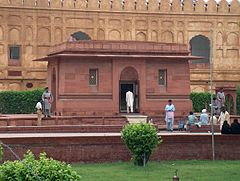Tomb of Muhammad Iqbal
| Tomb of Muhammad Iqbal | |
|---|---|
| (Urdu: مزار اقبال ; Mazaar-e-Iqbal) | |

Mausoleum with Badshahi Mosque in the background
|
|
| General information | |
| Type | Mausoleum |
| Architectural style | Mughal |
| Location |
|
| Design and construction | |
| Architect | Nawab Zain Yar Jang Bahadur |
The Tomb of Allama Muhammad Iqbal, or Mazaar-e-Iqbal (Urdu:مزار اقبال) is a mausoleum located in Iqbal Park in the Pakistani city of Lahore, capital of Punjab province.
Iqbal was one of the major inspirations behind the Pakistan Movement, and is revered in Pakistan as Muffakir-e-Pakistan (The Thinker of Pakistan) or Shair-e-Mashriq (The Poet of the East). Iqbal died on 21 April 1938 in Lahore at the age of 60. Thousands of visitors come to the mausoleum every day to pay their respects to the poet-philosopher. It is said that Mustafa Kemal Atatürk sent earth collected from Maulana Rumi's tomb to be sprinkled on this grave
Soon after Iqbal's death in April 1938, a committee was formed that was presided over by Chaudhary Mohammed Hussain. The initial round of the designs submitted by distinguished architects was not satisfactory. The committee suggested to innovate a new combination rather than following a specific school of architecture. The final design, thus, broke away from Mughal tradition and comprised a combination of Afghan and Moorish architecture.
A major problem in the realisation of this monument was a lack adequate funds. The committee resolved not to accept any donations from the local governments and state rulers, and so funds were raised through the contributions from Iqbal's friends, admirers and disciples.
The architecture reflects a combination of Afghan and Moorish styles. The structure is entirely constructed of red sandstone, which was brought from Jaipur, British India, and building marble from Makrana, Rajputana. After the independence of Pakistan in 1947, construction was affected due to export restrictions of red stone from India. Six couplets of a ghazal are carved from Iqbal's peotical work Zabur-e-Ajam (Persian Psalms) on the mausoleum's interior surfaces. Outside, there is a small garden, distributed into small plots. The mausoleum was designed by Hyderabad Deccan's then Chief Architect, Nawab Zain Yar Jang Bahadur and took thirteen years to build at a cost of about one hundred thousand (Rs. 100,000) Pakistani rupees. The major reason for delay was the stoppage of red-stone from Jaipur in post-independence India.
...
Wikipedia
